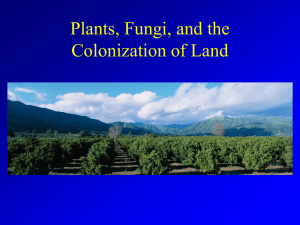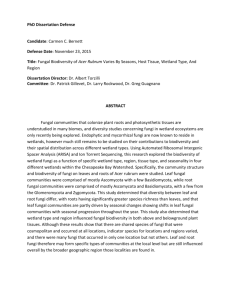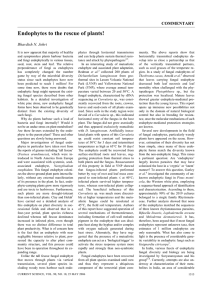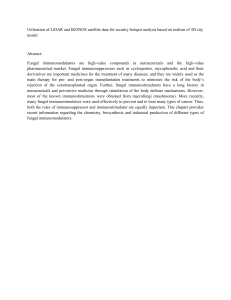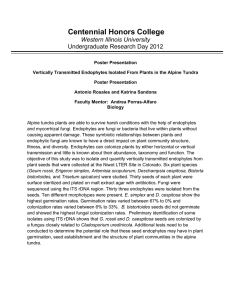View/Open
advertisement
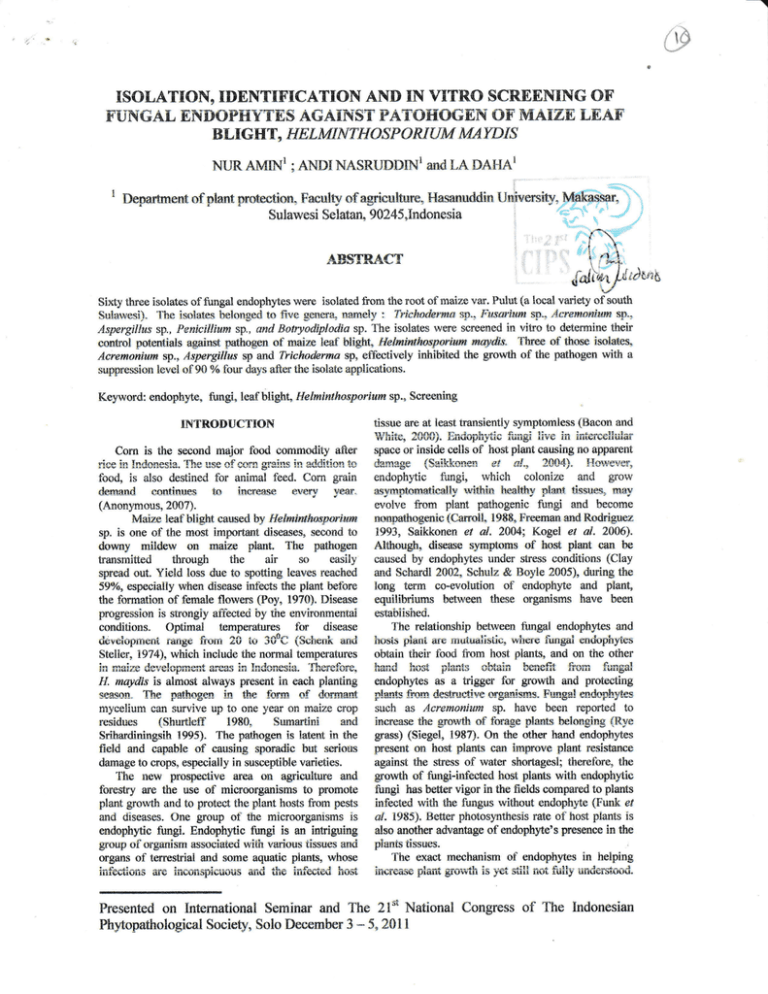
! ,.'{
TSOLATTON, TDENTTFTCATION AND IFI \TITRO SCTT.EENING OT
FUNGAL ENDOPHYTE$ AGATNST PATOHOGTN UT.&TAT&E LEAF
BLIGHT, I{E [, MI NTHO S P O Rl UM IL'IAYDI S
NIJR AMIN' ; ANDI NASRt.lDDtrNr and LA DAHA'
I Deprrtm*nt rrf nlant protection- Faculry of agriculture. Hasanuddin
{Jniversit,v- Makassar^
Sulawesi Selatan, 90245,Indonesia
a
pe'trD
a
ii
i,'ri
I +t-
f:'l-
u,rlio{.rf.i;lt';5
Sixty three isolates of fungal enrlcphytes were isolatcd f'rom the rtot cf maize var. Pulut (a iooal variety of south
Srrla.rvesi)" The isoiates helonged tc five genera. namelv : Tricltodenna st',.- l;ilsarium 3n." ,,lt:rewortitgtt sp".
lspergillus sp., Penicilliutn sp., and Botryodiplcdi* sp. The isolates t.vere screeneci in vitro to de.ierrnine their
eontrol potenlials against rrathogen of maize leaf blight- Helmbthaspariuru ma.vdis. 'Ihree of lhose isolates.
Acremoniurn sp., Aspergilhtr sp and Trichaderma sp. etfbctiveiy inhibited ths grow'th of the pathogen with a
suppression level of90 64 firur days after the isolate ap;rlicatiens.
Keyrvord: endophyte, fungi, leaf bli ght, Heln inthosporiunt sp., Screening
tissue are at least transientiy symptomless {tsacon and
INTRODI.}CTION
Com is the second major food commadity alter
rlee in In,Jcnesia. The u;e tf ccrn greins i,"r sdclitit'r: tc
forr.l, is als* destined for arimal feed. Con: grain
demarrrl contint:r$
t$
increase everv
vear.
(Anon1xraus, 2007).
Maize lear hlight caused bv Heiwinthasprtriunt
sp. is one cf the most important diseases, second to
downy miiderv o$ mair-e piant. I'he pathogen
transmitted through the air $o easill'
spread out. Yield loss due io spofiing leaves reashed
59'%, especially when disease inlects the plant betbre
the formation of female flowers (Poy, 1970). Disease
progression is suongiy ait'ecteci by rire environmentri
conditions. Optimal temperatures tbr disease
dcrciuprtierri laargc iiurrr 2C i., -i00i: isuircr,i old
Steiler. i974), which include the normal tempcratures
i-, *..,;,.".,,,{-,,."1,-,**..-r
nrl*!.-!
uvrlrvPrritl[
iti
.-. arrlrl\\ r1..i^-L-..:^
4'-.-^:
ii iiilu, -uuu/, a,aiuupu-rrr! rurisr
$pacs or inside cells of host plant
,-t*mos..
/ (*il'l-c,ncn
.?i n!
117r-.lr
l- r',.{,"-4".i"'
--.',,., ar,
rrrs'JrrL;!o,
*i.4,
'f-t..q.'+'.-..:
rtleiliuts.
H. maydis is almost ahvays preseni in each planiing
qea-enn The ntthogen in th+ fi:rm tf dsrfirtant
r'_'--'e'-'
enrJophytic
r:--- :^ :-t--^^11."1-rri9 rti iirLtlLuillll4t
causing no apparcnt
?llllrt\
tfrrrrrerr+r'
fungl, lvhish col*nize and
grow
,rlymFtanatically- u'ithin heatthy pl;mt lis5r.tes. nr*v
evolve li'om plant pathogenic fungi and become
nonnathogenie iCarroll. 1988. Freeman anel Rodriguez
1993" Saikkonen et al. 2AA4; Kogel e/ al. 2006).
Althotrgh, disease symptofi$ of host plani can he
cause<i by endophytes under stress conditions (Clay
and Schardl 2002. Schulz & Boi'ie 2005), during the
long term co-evolution of endophyte and plant,
equilibriums befr.veen these +rganisms have been
esmbiished.
'l'he relationship betr.veen t'ungal endophytes anel
lrtrsis piaui are rluiuaiisiiu, wircrc iungai errduphytuu
obtain their food irom hnst plants, anei on the other
1.^-,1
fr(r!v
L-,-r
rA,J(
".!,,-r.,
trrJrr!-r
endophytes as
L.,*^f:,
wr.91r!
^L...:'rrL4ttt
t'*,,-rrUrrr
a trigger for grorvih and
n...."^l
rull6dr
protecting
nlqntq frnm rleqtnrctir,'c nrc+nismc Frtnsrrl cndnnhr,fae
mycelium can survi.,'e up to one ysar on ntaize crop
such as Acrernoniutn sp. have been reported to
anel
increase the gro'.l.th of fotage plants treionging {{i.1,e
grass) (Siegel, 1987). On the other hand endcrphyte.*
present on hosi plants can improve piant resistance
against the stress of water shortagesl; therefore, the
nesidues {Shurtletf
1980. Sumartini
Srihardiningsih l99si. The pathogen is latent in the
field anci capable of causing sporadic bui serious
damage to crops" especiaily in susceptible varieties.
T'he new prospective ares on agriculture atrd
torestry are the use of microorganisms to promote
plant grcu,th and ter protrct the piant hosts frorn pests
and drsease$. One group ot the microorganisms 1s
ardophytic fungi. Eudophytic fungi is an intriguing
group oiorganisrn associared wiih r.arious tissues and
growth of fungi-infected host plants with endophytic
fungi has better vigor in the fields compared to piants
infeeted r.vith the fungus rrithout enrlophyte (Funk er
1985). Better phoiosynthesis rate of host plants is
also another advantage crfendophyte's presence in the
piants tissues.
c/.
The exact mechanism of cndophytes in heiping
organs of ten'estrial and some aquatic plants. wherse
:-..f^-r:.-"-iiirovLrwii}
--^
st€
:.-^.---.-r----.--rulvirttruuuus
^.-l
6riu
aLrIlE.
:--3-^{-"
rtli&!t&\t
J L^-.
trirsl
r-'
'.--^--..
IlLlrer$
--l^--
i-
-----.rlpriJr$ Erulrlrr
li
-.-.
dvua
a--tl--
---.
-L:ll
rit]L
ruliy --*l-*.r--I
ulisut]tutru.
lLlrl
Presented on Intsmational Serninar and T'he 21"' National Congress
Phytopathological Society, Solo December 3 - 5, 201I
of The Indonesian
l
However, there is strong suspicion that endophyte
infection induces the host piants to prcduce
substances such as auxin growth regulator or other
grorvth hormones (Bacon et al. 7986, Clay 1984,
et sl.
Latch
1985).
An other in vitro
study
demonstrated that endophytic {imgr were capable of
producing auxin (Porter er qt. 1985!..
The c,ritical roles of various genera of fi.u:gal
endophyre in proiecring piants havc ttucn reporteii by
various researchers as listeci in Table l.
Tabel 1. Negative etfect of fungal endophyes against
pesis and paiirogerrs
lielo
Mnterirl tnd Methods
1.
Isolation of Fungal endoPhYtes
Fungal endophl'tes were isolated tiorn the roots
of
af
South Sulawesi,
inclonesia;" ihe roots wero washed in the running tap
rvater and then eut into pieces with the size of about
0,5 crn. 'iire roui picces rvere ricriiiz.eil usilg sudiuiri
hypochiorite (2"5%) for five minutes, then washed
maize var. Pulut {local variet,v
--.:rt^
vlrui ^.^-:l^
Jrillrc
-rL,.
^-.....t^.,
(irE +:*.,TrLrL
r\rur *:^^.'4
trrrllJ! rrr! -^^+
ouu4utl {:,...
Pr!!w ''.^*'
placed on the medium of potaio dextrose agar (PDA)
in qevpral florri ..lichpe (dianr- O cm\ 'llhe prtri fliShCS
r,vere kept in incubatoi at tempsrat$re 28 "C). The
observation of the growth of the fungus were done
every day. The fungus^rvere then purified aad stored
in the reirigerator at 4uC iiir further rtse in subsequent
shrdies.
l.
Isolation
of m*ize leaf hlight
H e lmint h o s po r I u m may dis
in vitro
fuIaize leaves ini'eeted by leaf i:iigi* disease n'ere
collected t'rom Antang, Makassar, South $ularvesi
Indonesia and brorrght back to our laboratory. The
leaf samples rvere cut into small pieces (diam' I cm).
The cuts were made betweea healtlry and int'ected
areas of the leaves in order io assure that ihe active
growing part of the pathogen was included in the
.Ii:e
pieces.
ie*f pieces tvere then steriiseri by
immersing them in l7o natrium hypochloride (NaOCl)
roiuiion iur li"e triirruie;. Aiier tire leal'pi*ccr were
air drieci for several minutes, they were put into
ilt|llr,
,.^'.*^i-l-^
-,...^*.1 D.,r-i.l:.'1".',
!rrL.r L-*t
rLuL:'rir. --'
iDT-iA
ril ltr.u
^n,{ rl"or-;iii iiiJ;;Utr lJiiaJiiirirb
J'i','iji3i
oC
t 7 au
for three days. Fungal
insub*tor at temperature 28
leaf nieeec rvns
nathnoen H ntmtiit ornwing
__ the
''"e nn
'
purified by tranfening it into aew growth PDA.
3. In yitro screeming of fungal endophytes
The chemical basis of fungal endophytes to
nrnm^le nlnnf ornrr,'fh iq rrnknnwn trt iq rocqihle that
the fungus produce, or induce the plant to produce,
auxin-like plant gror,vth resulators. or they ma3' alter
hormoue metabolism (Lxh et 41. 1985). Auxin-like
indole compounds have been isoiated in vitro from
culture
{Porter
of the
et al,
fungal endophyne Blanria epichlae
1985). The production of ihese
compounds may reflect an alteration of nitrogen
metabolisrn and assirnilation in the infected plant
(llacon, et al.79E6).
The objective afthis investigation
r+'as
to isolatioe-
i<ieniiiicariein and in viuo screening of iungai
endophytes frorn maize root against paihogen of
----!-Irrgtz€
.-" --. J,'^^f L!:
-L-,lL I 7i^Y tl--i-.rr.
u t,>.
llt t lt t l,ltJ- --pul--.:..-"
I u I l a fi taal
re.lr
ut tEt
t
is+l*tes against pathogen of maize leaf
blight, {I elmlnth osportam maytlls
The endophl4e isolates obtained from maize roots
rvere screened in vitro for their abiiity in inhibiting the
grorrth of the rnaize ieaf blight pathogen, I{. maydis,
isolated from maize teaves (decribed before)- On each
Petri dish containing PDA, an endophyte isolate and
I{. maydis isolate (eech about I cm diam.) rvere placed
on the opposite sides ofthe dish, about 2 cm from tile
qenter line dividing the PDA into two parts.
Eauir isuiaie ireailttenl had 5 rrpiiualiuls of unt
dish each. The size of H. noydis coiony forming in
.-.-,-L -l:.,L..,^..,1,.+^*:*^J
€{vrr vrJrr rr 45 ulLcl rllltrlu
each
of the colony
*oao,r*inc
fbrmula:
L., *^^.,,,*:-^
rrrt
u, rrrlosr
+L6 l+n^.1. I ur
af
Lrrv rlrr6u
perpendicular diameters. The
rc<rrlic rrrere f han errhier.ied tn thn llrllrrrvino
